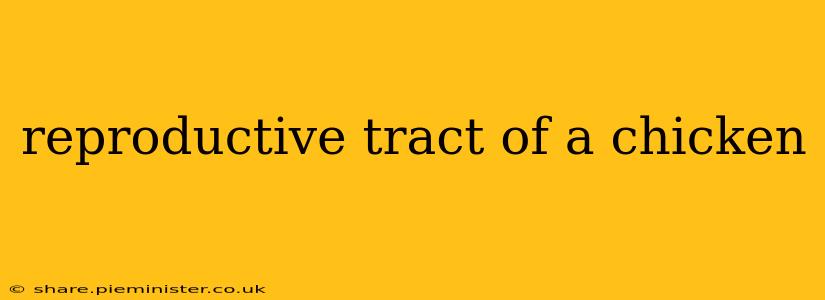The reproductive tract of a hen, a fascinating and complex system, plays a vital role in egg production. Understanding its anatomy and physiology is crucial for anyone involved in poultry farming, veterinary science, or simply curious about avian biology. This detailed guide will explore the intricacies of the hen's reproductive system, answering common questions and providing in-depth knowledge.
What are the main components of a hen's reproductive tract?
A hen's reproductive tract is comprised of several key components working in concert to produce an egg. These include:
-
Ovary: This is where the yolk (ovum) develops. Unlike mammals with two ovaries, hens possess only one functional ovary, typically the left one. The right ovary usually atrophies during embryonic development. The ovary contains thousands of potential ova, each enclosed in a follicle. As a follicle matures, it increases in size and eventually releases the yolk into the oviduct.
-
Infundibulum: This funnel-shaped structure receives the released yolk from the ovary. Fertilization, if a rooster is present, occurs here. The infundibulum holds the yolk for approximately 15 minutes.
-
Magnum: This is the longest part of the oviduct. It's where the albumen (egg white) is added to the yolk. This process takes about three hours.
-
Isthmus: Here, the two shell membranes are added to the egg. This stage lasts about 1 hour.
-
Uterus (Shell Gland): This is where the egg's shell is formed. The shell is primarily composed of calcium carbonate. This process takes around 20 hours. The egg also acquires its characteristic color here.
-
Vagina: This is the final section of the oviduct, connecting the uterus to the cloaca. The egg passes through the vagina just before being laid. The vagina also plays a role in lubricating the egg for easier passage.
-
Cloaca: This is the common opening for the digestive, urinary, and reproductive tracts. The egg is expelled from the cloaca during laying.
How long does it take for a hen to lay an egg?
The entire process, from yolk release to egg laying, takes approximately 25-26 hours.
What hormones are involved in egg production in chickens?
Hormonal control is crucial for egg production. Key hormones include:
-
Follicle-stimulating hormone (FSH): Stimulates the growth and maturation of ovarian follicles.
-
Luteinizing hormone (LH): Triggers ovulation, the release of the mature yolk from the follicle.
-
Progesterone: Plays a significant role in the development of the egg's shell and uterine secretions.
How does the hen's reproductive system differ from a mammal's?
Several key differences exist:
-
Single functional ovary: Hens possess only one functional ovary, unlike mammals with two.
-
Shell formation: Eggshells are unique to avian reproduction, providing protection for the developing embryo. Mammals don't produce eggs with shells.
-
Oviparity: Hens are oviparous, laying eggs that develop externally. Mammals are primarily viviparous, giving birth to live young.
-
Cloaca: The cloaca serves as a common opening for the digestive, urinary, and reproductive systems in birds, unlike mammals with separate openings.
What factors affect egg production in chickens?
Several factors can influence egg production, including:
-
Breed: Different chicken breeds have varying egg-laying capabilities.
-
Age: Egg production peaks in hens between 18 and 24 months of age.
-
Nutrition: A balanced diet is essential for optimal egg production. Calcium intake is particularly crucial for shell formation.
-
Lighting: Light exposure influences hormonal levels and egg production.
-
Health: Diseases and stress can significantly reduce egg production.
-
Genetics: The genetic makeup of the hen influences its reproductive potential.
Understanding the reproductive tract of a hen provides valuable insights into the intricacies of avian biology and the factors that affect egg production. This knowledge is critical for sustainable poultry farming practices and ensures the healthy development of this essential food source.
